By Jill Thayer, Ph.D., Contributing Art Historian/Scholar; book essay for Argentine artist Mario Bursztein.

“Danza humilde,” 2008 Digital print and mixed media. @ Mario Bursztein.
“My oeuvre is a fluid, technological brush-stroke, a studied structure, a virtual geometry tinged by movement. It is the summation of a long, never-ending quest.”
– Mario Bursztein
Mario Bursztein creates a visual language exploring the formal constructs of art and the structural relationships of architecture. This confluence of traditional genres and a shift to digital media brings his aesthetic mastery and perspective renderings to a new level. The articulate fluidity of his process allows him to create digital compositions in Photoshop and Illustrator then manipulate the print using applications of oil, watercolor, and other media. As a result, the embellished piece is dynamic, exquisite, and unique. The artist’s investigative approach and technical expertise is revealed in a seamless transition from computer to canvas in media and methodology.
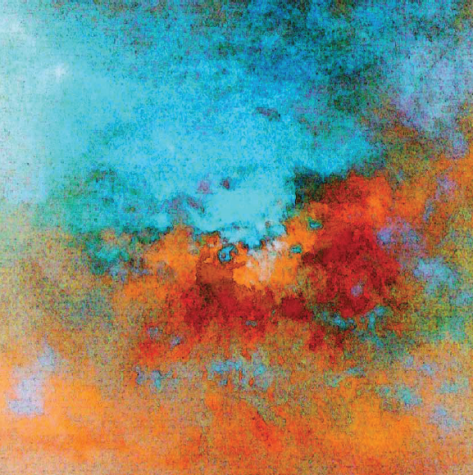
“Galaxia,” 2003 Oil on canvas. @ Mario Bursztein.
Bursztein deconstructs line and form into “organic geometry,” as he expounds upon the traditional practices honed throughout his career. His compositions of geometric abstraction engage a common narrative with references to Latin American Modernism and nuances of Surrealism, Cubism, Futurism, Constructivism, Neo-figurative art, Op art, Kinetic art, and Abstract Expressionism. Vibrant incarnations with titles such as: “Birth,” “Genesis,” “Manifestándose,” “Multitud,” “Emblemas,” “Fantasia,” “Interpretación del enigma,” “Habitat utópico,” “Futurismo,” “Galaxia,” “Políticos amorfos,” and “Thinking” ponder complexities of culture, politics, colonialism, idealism, life, and the universe beyond in a visceral observation that questions a broader discourse.
“Art is the expression of spontaneity, freedom, faith, optimism and our transcendent role as social beings.”
The works are ethereal and enigmatic as color harmonies form a constellation of wonder. Compositions range from amorphous shapes devoid of form to graphic geometries that appear intentional and calculated. Spatial relationships and interaction of elements invite semiotic interpretation, as constructs of design bring allegory and analogy to a postmodern symbolism.
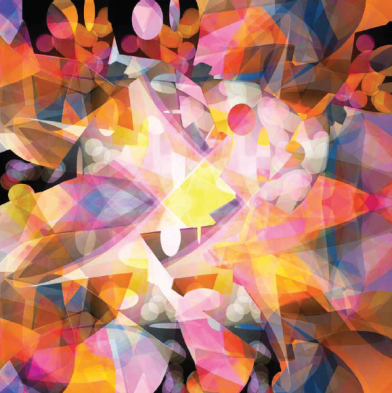
“Multitude,” 2000 Digital print and mixed media. @ Mario Bursztein.
Bursztein’s influences are diverse including artists: Da Vinci, Delacroix, Géricault, Monet, Caravaggio, Manet, Cézanne, Bretón, Juan Gris, Braque, and Léger to name a few. Their tenets of distinction infuse insight and acuity in practicum and passion. His radiant symmetries are reminiscent of the works by Abstract Classicist Karl Benjamin, whose poetic motifs and arrangement of form were lyrical, structured, and intuitive.
Kandinsky comes to mind for his purity of abstraction and non-objective resonance. The Russian theorist considered the meditative qualities of art on the soul citing theories of aesthetic and the psychology of color in “Concerning the Spiritual in Art.” He stated, “Of all the arts, abstract painting is the most difficult. It demands that you know how to draw well, that you have a heightened sensitivity for composition and for colors, and that you be a true poet. This last is essential.” Bursztein channels this philosophy in a focused acumen of artistic reverence. His approach, as Kandinsky, offers a spiritual renewal though abstract form and color that defy cultural and physical boundaries. The intricacies in his paintings become touchstones of existence––sublime windows to the unknown. The hope of enlightenment, the power to change, and the promise of future are reveries set in motion.
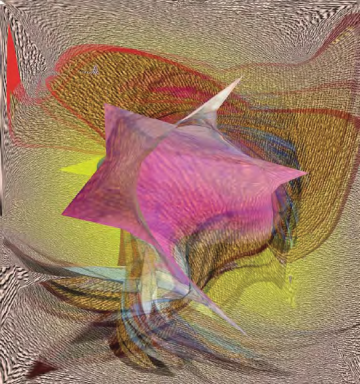
“Interpretación del enigma,” 2014 Digital print and mixed media. @ Mario Bursztein.
Mario Bursztein’s imagination draws upon the theories of Ilya Prigogine, A Nobel Prize recipient in Chemistry (1977) who was honored “for his contributions to non-equilibrium thermodynamics, particularly the theory of dissipative structures.” The Nobel Laureate’s theoretical framework on the big bang imparts a shift in consciousness that brings structural beliefs into question.
In an interview referencing his piece, “Homenaje a Ilya Prigogine,” Bersztein shares the impact of Prigogine’s contributions and implications of his work:
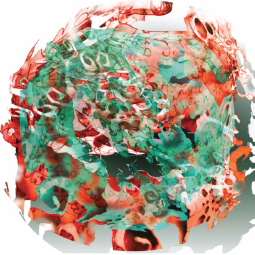
“Politicos amorfos,” 2015 Digital print and mixed media. @ Mario Bursztein.
“He introduced me to the mystery behind the different universes and galaxies, stars, planets, suns, and celestial space. His ideas fascinated me, as did those of Einstein, and Stephen Hawking, with their theories about the atom, intra-atomic particles, black holes, the velocity of their trajectories, their movements. In summary, all of that limitless exterior and interior space has an indescribable beauty like a work of art. Imagining and visualizing these mysteries is a real inspiration for me.”
Analysis and contemplation in the deep recesses of space are evident in many of Bersztein’s works: detailed patterns and gradations on signature shapes resemble a planetary nebula in a universe of creation; astro blues, viridian greens, soft pinks, and warm hues produce a rich saturation of cool and incandescent tones in a spectrum of color; luminous planes and topographical illusions suggest where civilizations may have formed and disappeared over time… What is seen and unseen are allusions in the subtext. A never-ending beauty in the continuum of life enraptures Bursztein in a quest to unravel the mysteries of the world. This visualization inspires his path in a thought-provoking journey of enlightenment.
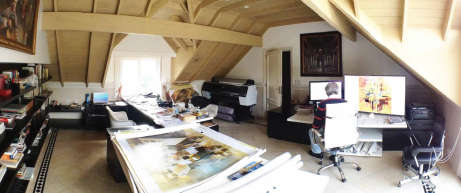
Mario Bursztein in studio. © Mario Bursztein.
For more on the work of Mario Bursztein, see: www.mariobursztein.com
__________
Jill Thayer, Ph.D. is an artist, educator, art historian, and curatorial archivist. As an oral historian, she explores the narratives and socio-political contexts of people and their contributions to the cultural discourse. She received her doctorate in Cultural Studies/Museum Studies with emphases in contemporary art history, exhibition theory, design theory, and visual culture from Claremont Graduate University (2011) with transdisciplinary study in global strategy and trade at St. Peter’s College, University of Oxford, UK. Dr. Thayer is Professor of Art History for Santa Monica College in Art Appreciation: Global Visual Culture; and South University, Savannah, Georgia; Associate Professor of Art History for Allan Hancock College, Santa Maria; and Associate Faculty for the MBA program at Post University Malcolm Baldrige School of Business, Waterbury, Connecticut. Her postdoctoral oral history series, “In Their Own Words: Oral Histories of CGU Art” (2012) features CGU professors emeritus and is included in Archives of American Art at The Smithsonian Institution.
You must be logged in to post a comment.